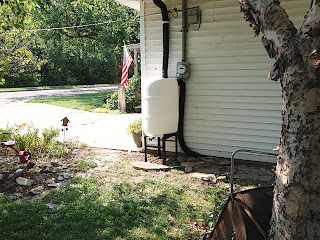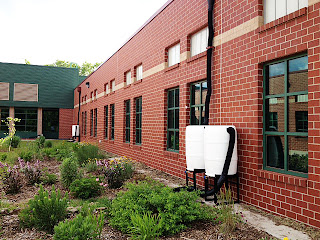An Article from today's paper here in Wichita Ks. Now is the time to start planning on how you will be using your water this summer. Rain barrels give you many options on being more conservative with your water. We also use soaker hoses so we are not watering areas of our garden that do not need the water. We have planted native plants that are drought tolerant and reserve most of our rain water for our season vegetables like tomatoes and cucumbers and beans. We also have our soaker hose go though the herb garden.
The intense drought that crippled much of the growing season for
numerous states in the nation’s mid-section in 2012 is showing little
sign of easing early in the new year, weather officials say.
But some Kansas forecasters retain hope that enough moisture will fall to provide for a decent winter wheat crop in 2013.
“I’m reasonably optimistic,” AccuWeather vice president Mike Smith said in an e-mail response to questions from The Eagle.
Long-range forecasts offered by computer models suggest precipitation levels will be normal from February through June, he said.
“That wouldn’t break the drought but it would give enough moisture for the wheat crop,” Smith said.
Smith
said the main reason for his optimism is that the high-pressure dome
that camped out over the heartland for most of 2012 shifted west – well
out into the Pacific Ocean – in early December and shows no signs of
moving.
“That is in nearly an ideal position to guide storms into our region,” he said.
Wichita and eastern Kansas need the moisture.
Salina’s
rainfall for 2012 was more than 13 inches below normal and Chanute’s
was nearly 10 inches. Wichita’s total was almost 8 inches below normal.
Since
last summer, precipitation across the region is running 25 to 50
percent of normal, according to a drought information statement issued
late last week by the Wichita branch of the National Weather Service.
According
to the National Oceanic and Atmospheric Administration’s Palmer Drought
Severity Index for Dec. 29, 6 to 9 inches of rain is needed in the
eastern third of Kansas to break the drought. Most of the rest of the
state needs 3 to 6 inches.
“This precipitation can not come all at
once, but needs to arrive in staggered intervals in order to minimize
runoff and maximize ground absorption,” the drought information
statement said. “This will be tough to accomplish during the winter
months due to historically less precipitation during the winter, and
will likely need to wait until spring at the earliest.”
Indeed,
the Climate Prediction Center forecasts the drought to persist in most
of the western half of the U.S. through at least the end of March – from
eastern Iowa and central Missouri west to the Pacific Ocean in southern
and central California and the Nevada state line in northern
California.
A wet winter and early spring – along with a growing
season that ran two to three weeks ahead of normal – helped Kansas wheat
farmers avoid the worst of the drought that began to set in by early
summer, leading to a 38 percent increase in total bushels over the year
before, according to Kansas Agricultural Statistics.
But warm
temperatures and dry weather in the nation’s wheat belt had the current
winter wheat crop in its worst shape in decades in late November,
according to government officials.
While there have been spotty rains around Kansas in the fall and early winter, substantial deficits remain.
Water
levels at most of the state’s reservoirs are down. Cheney Reservoir,
for example, has less than 60 percent of its normal water capacity. Most
of Cheney’s boat ramps are surrounded by land.
Soil moisture
levels in early January ranged from 8 inches in eastern Kansas to 12
inches in western parts of the state, according to the Climate
Prediction Center. That is 4 to 6 inches below seasonal normals.
The
center projects below normal precipitation across the High Plains for
much of the growing season, based on current weather patterns, said Jeff
Hutton, warning coordination meteorologist for the Dodge City branch of
the weather service.
“Precipitation on average will ‘probably’ be
below normal again this year but perhaps not that far below normal,”
Hutton said in an e-mail response to questions. “That being said, it
will take several months in a row of above normal precipitation to
diminish the severity of the ongoing drought.”
A snowy December –
by western Kansas standards, at least – is a decent first step. Dodge
City recorded 6.9 inches of snow, which is 2.8 inches above normal for
December
Read
more here:
http://www.kansas.com/2013/01/07/2627817/kansas-drought-shows-little-sign.html#emlnl=Morning_Headlines_Newsletter#storylink=cpy

















